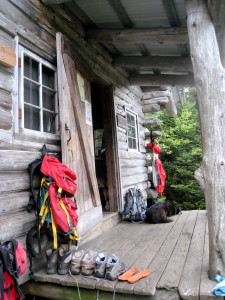Vermont is a state of mud, snow, rocks, roots, black flies, mosquitoes, cliffs, swamps…. sometimes all at once! Make sure you take the “10 Essentials” on your hike:
- Navigation (map and compass)
- Sun Protection (ex: sunglasses, hat, sunscreen)
- Insulation (extra clothing, rain gear)
- Illumination (headlamp/flashlight)
- First-aid Supplies (include any medication you take regularly)
- Fire (waterproof matches/lighter/candles)
- Tools/Repair Kit for gear (and know how to use them!)
- Nutrition (extra food)
- Hydration (water treatment/filtration system and/or extra water)
- Emergency Shelter (ex: tarp/emergency blanket)
HikeSafe
Wherever you hike, no matter what season or whether it’s a short hike or multi-day trek, be safe and follow the HikeSafe Hiker Responsibility Code.
You are responsible for yourself, so be prepared:
- With knowledge and gear. Become self reliant by learning about the terrain, conditions, local weather and your equipment before you start.
- To leave your plans. Tell someone where you are going, the trails you are hiking, when you will return and your emergency plans.
- To stay together. When you start as a group, hike as a group, end as a group. Pace your hike to the slowest person.
- To turn back. Weather changes quickly in the mountains. Fatigue and unexpected conditions can also affect your hike. Know your limitations and when to postpone your hike. The mountains will be there another day.
- For emergencies. Even if you are headed out for just an hour, an injury, severe weather or a wrong turn could become life threatening. Don’t assume you will be rescued; know how to rescue yourself.
- To share the hiker code with others.
Trailhead Safety
Please do not leave valuable property in plain view in your vehicle. Car break-ins sometimes take place at popular trailheads like those at Mt. Philo State Park and Camel’s Hump State Park. The Vermont State Police is doing their best to curb these break-ins but you can help by securing your valuables while hiking, or not bringing them at all.
Special Considerations:
Alpine Zones
If you’re hiking to the summit of Camel’s Hump, Mt. Mansfield, or Mt. Abe, you will be entering areas with some of Vermont’s only alpine tundra. The plants here are very fragile and are easily killed from both human and animal footsteps. Please stay on trail in these areas and leash dogs. Alpine zones are also subject to rapidly changing weather, so come prepared with the 10 Essentials and pay attention to weather changes.
Bears
Bears have become more active around the Long Trail System in the last few years. As of July 24, 2019, hikers are now required to use a bear box, bear can, or hang all their food/refuse/etc 12′ from the ground and 6′ from the tree and branch, and carry out all trash, on Green Mountain National Forest Land. The Long Trail and its side trails from Massachusetts to Route 17 (Appalachian Gap) are mostly on GMNF land. GMC recommends using these food storage methods on the entire trail. Find more information about the GMNF’s food storage order here. Find out more.
Hiking with your school, organization, business, or other group is a great way to experience Vermont’s trails and increase access to hiking. Groups have a larger impact on the trail and environment than individuals, and as such, there are some logistics and precautions to be aware of. This page has everything you need to know around planning, group size limits, permits, and various land use regulations.
Mud Season (Spring)
The State of Vermont closes all trails on state land, including those on Camel’s Hump and Mount Mansfield, from the beginning of mud season through Friday of Memorial Day Weekend. The GMC recommends avoiding other high peaks during this time as well, including Stratton Mountain, Killington Peak, the Lincoln Ridge (Mount Ellen to Appalachian Gap), and Jay Peak.
Why? Melting snow means muddy trails, especially at higher elevations. Muddy trails mean hikers are more likely to walk next to the path, damaging plants and expediting erosion. Damaged plants and expedited erosion mean widening trails and sometimes the eventual loss of all topsoil. Read our mud season blog to find out where you can hike during mud season.
Check out the Day Hiker’s Guide to Vermont or call the GMC Visitor Center at (802) 244-7037 for some low-elevation mud season hikes!
Hunting Season (Autumn)
Hunting is allowed on all GMC owned and managed lands, including along the Long Trail and Appalachian Trail corridors in Vermont. For comprehensive year-specific dates, see the VT Fish & Wildlife website. Here are some seasonal safety tips:
- Wear blaze orange clothing, visible from both the front and back.
- Avoid wearing brown or white, the colors of a deer.
- Be especially careful while hiking in valleys and near roads and trailheads.
- Avoid hiking during dawn and dusk due to low visibility.
- Please leave dogs at home. If you do bring a furry friend, make sure they have blaze orange on as well.
- Wave to make your presence known to hunters.
Winter
Vermont winters are beautiful times to hike but allow very little room for error. Also, keep in mind that the Long Trail is not maintained for winter hiking. Here are some seasonal safety tips:
- Start your hike early. Daylight is short in the winter and darkness comes suddenly.
- Carry a topographical map and compass, and familiarize yourself with your route ahead of time. The Long Trail blazes are white, which is harder to see against snow. In deep drifts, blazes may be buried or appear at knee height.
- Consider using snowshoes and microspikes.
- Know the signs of hypothermia and frostbite and how to treat them.
- Use layering to avoid sweating and carry an extra change of clothes, such as a dry set of long underwear and wool socks.
- Remember to hydrate! Dehydration increases susceptibility to hypothermia.
- View some more specific tips on our blog – Winter Hiking Preparedness Part 1 and Part 2



















